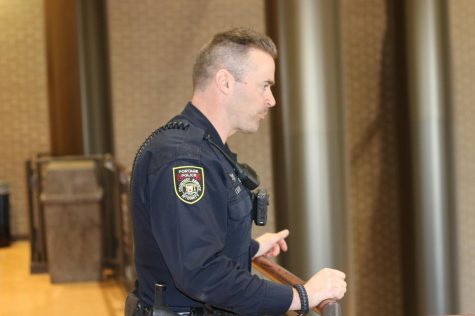Proposed legislation could make schools safer by providing more SROs, counselors
March 27, 2018
Two weeks ago, a gunman opened fire at Great Hills High School in Southern Maryland. Within one minute, he was encountered and stopped by the school resource officer, who was also a former SWAT team member. While being celebrated by some as a classic example of “the only thing that stops a bad guy with a gun is a good guy with a gun,” this scenario is not only unrealistic in general, it is especially unrealistic here in Portage, where there are only two school resource officers for the entire district.

This leaves Nate Slavin, the SRO at Portage Northern, covering not one building, but seven. Even though he has 9 years of Army experience and 11 years of SWAT experience, the chances that he would be able to respond in the same way that the Maryland officer did are greatly limited by the fact that there’s a chance that he might not even be in this building at all.
Slavin, who serves Portage Northern, North Middle, Portage Community Education Center, Amberly, Angling Road, 12th Street, and Haverhill, states that serving half of the Portage Public School District creates not only time management issues, but also problems serving each building effectively and efficiently. “The National Association of School Resource Officers (NASRO) concept of school based policing divides up my time as follows: 45% as a guest speaker, 45% as a mentor/role model and only 10% conducting actual law enforcement. NASRO recommends one SRO per building. With seven schools, this statistical breakdown is impossible. If I had to guess, my statistical break down would be 25% guest speaking, 25% mentoring and 50% law enforcement,” he says.
There is a new bipartisan proposal in the Michigan legislature that could help change that, however. Last Thursday, a team of leaders in law enforcement and education proposed a $120 million security initiative that would fund both more counselors and more school resource officers.
The proposal offers strategies to improve school safety while avoiding the divisive issue of gun control. More counselors will help address students’ mental health needs, while more SROs -500 to be exact- will help ensure that fewer districts are spread as thin as Portage when it comes to law enforcement in schools. Many districts are worse off: according to WWMT, only ⅓ of public school districts in Michigan have any SROs at all.
The specifics of the proposal include state funding in the following areas: $50 million per year for SROs, $50 million per year for counselors, and $20 million to provide important structural safety updates to schools. Schools receiving the funds would be checked for compliance at least once a year by local law enforcement. “The bill in question makes total sense to me. It is a multifaceted approach. It sets aside funding for 500 more SROs at the same time providing additional money for school counselors. It seems to be politically neutral, so I see no reason for this bill not to be passed on a bi-partisan basis.”
There are also other unique components to the proposed legislation. For example, schools will be required to report any threats made against them to law enforcement officials, and there will be a new way to hold students who make threats criminally accountable while also requiring that they undergo a mental health evaluation.
“This part of the law is key. Currently, Michigan law really only has one option for these types of threats and its a 20 year felony (False Report or Threat of Terrorism MCL 750.543M). So, if someone posts a threat against a school and even if they show no signs of carrying it out, I have a 20 year felony…or I have nothing. There needs to be a middle ground. Most “red flags” we see in the aftermath of these horrific events are not actionable by the police or mental health. They aren’t enough for the mental health professional to diagnose anything and they are not necessarily crimes. The legislature needs to give law enforcement and mental health professionals additional tools in their respective tool boxes,” he says.
For Slavin, this bill is a step in the right direction. “More SRO’s translates into safer schools!” says Slavin about the proposed bill. “It’s hard to quantify the benefits because the primary benefit may be the fact that someone chooses not to carry out an attack, simply because they know an SRO is always present. In our district, I would like to see an SRO at every secondary level building,” he says. While it will take time to implement, this bill, if enacted into law, will allow schools to take care of their primary concern: the safety of staff and students.









Snigda Narisetty • Mar 30, 2018 at 10:38 pm
This is a great point that was backed up very well with good research and quotes!